Andes: Laguna del Inca (Chile)
Three driving hours north of Santiago de Chile is
the alpine region of Portillo, part of the area
which is known as a winter sport resort. In
the immediate vicinity of the pass road, there is
a rather intact, very rich alpine flora
(Fig. 2-7)
composed of small shrubs, herbs and grasses.
Although belonging to the Mediterranean zone,
water is only moderately, if at all constraining
plant life at these high elevations. At slightly
lower elevations somewhat wetter conditions offer
a completely different flora
(Fig. 8-10).

1 -
Laguna del Inca (2700-2800 m)
1 -
Laguna del Inca (2700-2800 m)
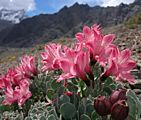
2 -
Alstroemeria spathulata (Alstroemeriaceae)
2 -
Alstroemeria spathulata (Alstroemeriaceae)
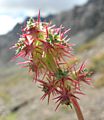
3 -
Acaena pinnatifida (Rosaceae)
3 -
Acaena pinnatifida (Rosaceae)
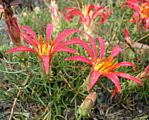
4 -
Mutisia subulata (Asteraceae)
4 -
Mutisia subulata (Asteraceae)
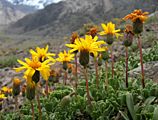
5 -
Haplopappus a.f. anthylloides (Asteraceae)
5 -
Haplopappus a.f. anthylloides (Asteraceae)
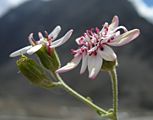
6 -
Leucheria sp. (Asteraceae)
6 -
Leucheria sp. (Asteraceae)
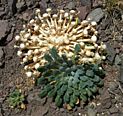
7 -
Calycera pulvinata (Calyceraceae),
a biennial species that forms a
rosette in one year and flowers, fruits and then
dies in the next year. This species is one
of the wide-ranging representatives of the high
Andean flora also found in Argentina and Bolivia.
7 -
Calycera pulvinata (Calyceraceae)
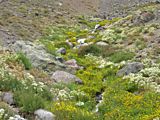
8 -
A lot of Calceolaria sp. (Scrophulariaceae)
can be found along rivers.
8 -
A lot of Calceolaria sp. (Scrophulariaceae)
can be found along rivers.

9 -
Trapeolum polyphyllum (Trapeloaceae) found
on otherwise bare scree with exceptionally showy
inflorescences and foliage.
9 -
Trapeolum polyphyllum (Trapeloaceae) found
on otherwise bare scree with exceptionally showy
inflorescences and foliage.

10 -
Small shrubs of Berberis empetrifolis (Berberidaceae).
10 -
Small shrubs of Berberis empetrifolis (Berberidaceae).











